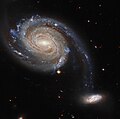Файл:NGC7752, NGC7753 - HST - Potw2142a.jpg
Перейти к навигации
Перейти к поиску

Размер этого предпросмотра: 604 × 600 пкс. Другие разрешения: 242 × 240 пкс | 483 × 480 пкс | 774 × 768 пкс | 1031 × 1024 пкс | 2063 × 2048 пкс | 3908 × 3880 пкс.
Исходный файл (3908 × 3880 пкс, размер файла: 3,2 МБ, MIME-тип: image/jpeg)
История файла
Нажмите на дату/время, чтобы посмотреть файл, который был загружен в тот момент.
| Дата/время | Миниатюра | Размеры | Участник | Примечание | |
|---|---|---|---|---|---|
| текущий | 05:11, 18 октября 2021 |  | 3908 × 3880 (3,2 МБ) | Fabian RRRR | == {{int:filedesc}} == {{Information |description={{en|1='''Invisible Galactic Gale NGC 4666 takes centre stage in this image from the NASA/ESA Hubble Space Telescope. This majestic spiral galaxy lies about 80 million light-years away in the constellation Virgo, and is undergoing a particularly intense episode of star formation. Astronomers refer to galaxies which are forming stars anomalously quickly as starburst galaxies. NGC 4666’s starburst is thought to be due to gravitational interact... |
Использование файла
Глобальное использование файла
Данный файл используется в следующих вики:
- Использование в ar.wikipedia.org
- Использование в az.wikipedia.org
- Использование в be.wikipedia.org
- Использование в ce.wikipedia.org
- Использование в de.wikipedia.org
- Использование в diq.wikipedia.org
- Использование в en.wikipedia.org
- Использование в eu.wikipedia.org
- Использование в fa.wikipedia.org
- Использование в fr.wikipedia.org
- Использование в mg.wikipedia.org
- Использование в mk.wikipedia.org
- Использование в sk.wikipedia.org
- Использование в tt.wikipedia.org
- Использование в www.wikidata.org